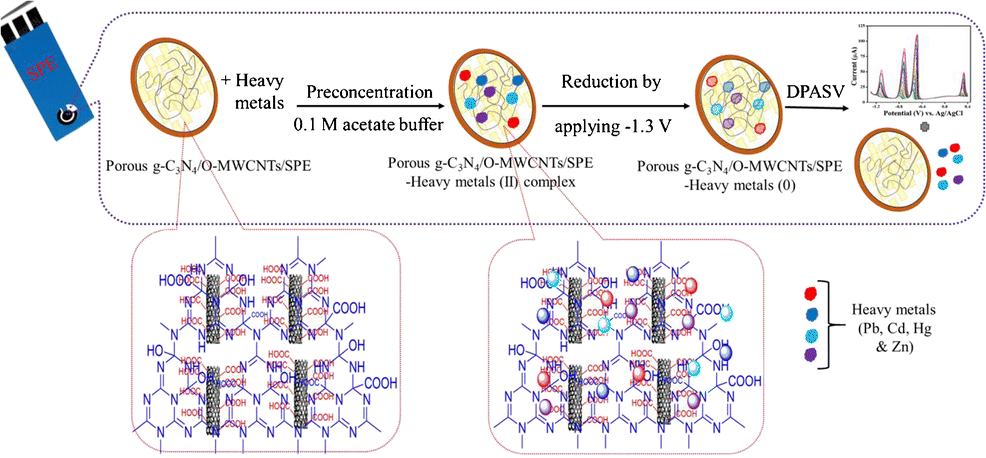当前位置:
X-MOL 学术
›
Microchim. Acta
›
论文详情
Our official English website, www.x-mol.net, welcomes your
feedback! (Note: you will need to create a separate account there.)
A nanocomposite consisting of porous graphitic carbon nitride nanosheets and oxidized multiwalled carbon nanotubes for simultaneous stripping voltammetric determination of cadmium(II), mercury(II), lead(II) and zinc(II)
Microchimica Acta ( IF 5.3 ) Pub Date : 2019-01-09 , DOI: 10.1007/s00604-018-3178-7 Manikandan Ramalingam , Vinoth Kumar Ponnusamy , Sriman Narayanan Sangilimuthu
Microchimica Acta ( IF 5.3 ) Pub Date : 2019-01-09 , DOI: 10.1007/s00604-018-3178-7 Manikandan Ramalingam , Vinoth Kumar Ponnusamy , Sriman Narayanan Sangilimuthu

|
AbstractA 3D nanocomposite consisting of porous graphitic carbon nitride nanosheets (p-g-C3N4-NSs) and oxidized multiwalled carbon nanotubes (O-MWCNTs) was prepared by simultaneous chemical oxidation of bulk g-C3N4 and bulk MWCNTs. This one-step oxidation results in the formation of acidic functional groups on the basal surfaces of both g-C3N4 and MWCNTs. Simultaneously, the O-MWCNTs are incorporated in-situ on the porous structure of p-g-C3N4. The acid functionalization and surface morphology of the nanocomposite were examined using attenuated total reflectance infrared spectroscopy, X-ray diffraction, and high-resolution transmission electron microscopy. The nanocomposite was used to modify a screen-printed electrode (SPE) which then was studied by using cyclic voltammetry, electrochemical impedance spectroscopy, and differential pulse voltammetry. The modified SPE exhibits excellent sensitivity and selectivity towards the simultaneous detection of the heavy metal ions Cd(II), Hg(II), Pb(II) and Zn(II), typically at −0.78, +0.35, −0.5 and − 1.16 V (vs. Ag/AgCl). The detection limits (at S/N = 3) range between 8 and 60 ng L−1 under conditions of stripping analysis. The method was applied to the simultaneous detection of these ions in various (spiked) food samples. The results demonstrated the good accuracy and reproducibility of the method. Graphical abstractSchematic of a highly sensitive and selective electrochemical method for the simultaneous detection of four heavy metals. It is based on the use of a screen printed electrode (SPE) modified with 3D porous g-C3N4 and O-MWCNTs, and of anodic stripping voltammetry.
中文翻译:

由多孔石墨氮化碳纳米片和氧化多壁碳纳米管组成的纳米复合材料,用于同时溶出伏安法测定镉 (II)、汞 (II)、铅 (II) 和锌 (II)
摘要 通过块体 g-C3N4 和块体 MWCNTs 的同时化学氧化制备了由多孔石墨氮化碳纳米片 (pg-C3N4-NSs) 和氧化多壁碳纳米管 (O-MWCNTs) 组成的 3D 纳米复合材料。这种一步氧化导致在 g-C3N4 和 MWCNT 的基底表面上形成酸性官能团。同时,O-MWCNTs 被原位结合到 pg-C3N4 的多孔结构上。使用衰减全反射红外光谱、X 射线衍射和高分辨率透射电子显微镜检查纳米复合材料的酸官能化和表面形态。该纳米复合材料用于修饰丝网印刷电极 (SPE),然后通过使用循环伏安法、电化学阻抗谱、和差分脉冲伏安法。改进的 SPE 对同时检测重金属离子 Cd(II)、Hg(II)、Pb(II) 和 Zn(II) 表现出出色的灵敏度和选择性,通常为 -0.78、+0.35、-0.5 和 -1.16 V(相对于 Ag/AgCl)。在溶出分析条件下,检测限(S/N = 3)范围在 8 到 60 ng L-1 之间。该方法用于同时检测各种(加标)食品样品中的这些离子。结果表明该方法具有良好的准确度和重现性。图解同时检测四种重金属的高灵敏度和选择性电化学方法示意图。它基于使用 3D 多孔 g-C3N4 和 O-MWCNT 改性的丝网印刷电极 (SPE) 以及阳极溶出伏安法。改进的 SPE 对同时检测重金属离子 Cd(II)、Hg(II)、Pb(II) 和 Zn(II) 表现出出色的灵敏度和选择性,通常为 -0.78、+0.35、-0.5 和 -1.16 V(相对于 Ag/AgCl)。在溶出分析条件下,检测限(S/N = 3)范围在 8 到 60 ng L-1 之间。该方法用于同时检测各种(加标)食品样品中的这些离子。结果表明该方法具有良好的准确度和重现性。图解同时检测四种重金属的高灵敏度和选择性电化学方法示意图。它基于使用 3D 多孔 g-C3N4 和 O-MWCNT 改性的丝网印刷电极 (SPE) 以及阳极溶出伏安法。改进的 SPE 对同时检测重金属离子 Cd(II)、Hg(II)、Pb(II) 和 Zn(II) 表现出出色的灵敏度和选择性,通常为 -0.78、+0.35、-0.5 和 -1.16 V(相对于 Ag/AgCl)。在溶出分析条件下,检测限(S/N = 3)范围在 8 到 60 ng L-1 之间。该方法用于同时检测各种(加标)食品样品中的这些离子。结果表明该方法具有良好的准确度和重现性。图解同时检测四种重金属的高灵敏度和选择性电化学方法示意图。它基于使用 3D 多孔 g-C3N4 和 O-MWCNT 改性的丝网印刷电极 (SPE) 以及阳极溶出伏安法。
更新日期:2019-01-09
中文翻译:

由多孔石墨氮化碳纳米片和氧化多壁碳纳米管组成的纳米复合材料,用于同时溶出伏安法测定镉 (II)、汞 (II)、铅 (II) 和锌 (II)
摘要 通过块体 g-C3N4 和块体 MWCNTs 的同时化学氧化制备了由多孔石墨氮化碳纳米片 (pg-C3N4-NSs) 和氧化多壁碳纳米管 (O-MWCNTs) 组成的 3D 纳米复合材料。这种一步氧化导致在 g-C3N4 和 MWCNT 的基底表面上形成酸性官能团。同时,O-MWCNTs 被原位结合到 pg-C3N4 的多孔结构上。使用衰减全反射红外光谱、X 射线衍射和高分辨率透射电子显微镜检查纳米复合材料的酸官能化和表面形态。该纳米复合材料用于修饰丝网印刷电极 (SPE),然后通过使用循环伏安法、电化学阻抗谱、和差分脉冲伏安法。改进的 SPE 对同时检测重金属离子 Cd(II)、Hg(II)、Pb(II) 和 Zn(II) 表现出出色的灵敏度和选择性,通常为 -0.78、+0.35、-0.5 和 -1.16 V(相对于 Ag/AgCl)。在溶出分析条件下,检测限(S/N = 3)范围在 8 到 60 ng L-1 之间。该方法用于同时检测各种(加标)食品样品中的这些离子。结果表明该方法具有良好的准确度和重现性。图解同时检测四种重金属的高灵敏度和选择性电化学方法示意图。它基于使用 3D 多孔 g-C3N4 和 O-MWCNT 改性的丝网印刷电极 (SPE) 以及阳极溶出伏安法。改进的 SPE 对同时检测重金属离子 Cd(II)、Hg(II)、Pb(II) 和 Zn(II) 表现出出色的灵敏度和选择性,通常为 -0.78、+0.35、-0.5 和 -1.16 V(相对于 Ag/AgCl)。在溶出分析条件下,检测限(S/N = 3)范围在 8 到 60 ng L-1 之间。该方法用于同时检测各种(加标)食品样品中的这些离子。结果表明该方法具有良好的准确度和重现性。图解同时检测四种重金属的高灵敏度和选择性电化学方法示意图。它基于使用 3D 多孔 g-C3N4 和 O-MWCNT 改性的丝网印刷电极 (SPE) 以及阳极溶出伏安法。改进的 SPE 对同时检测重金属离子 Cd(II)、Hg(II)、Pb(II) 和 Zn(II) 表现出出色的灵敏度和选择性,通常为 -0.78、+0.35、-0.5 和 -1.16 V(相对于 Ag/AgCl)。在溶出分析条件下,检测限(S/N = 3)范围在 8 到 60 ng L-1 之间。该方法用于同时检测各种(加标)食品样品中的这些离子。结果表明该方法具有良好的准确度和重现性。图解同时检测四种重金属的高灵敏度和选择性电化学方法示意图。它基于使用 3D 多孔 g-C3N4 和 O-MWCNT 改性的丝网印刷电极 (SPE) 以及阳极溶出伏安法。






























 京公网安备 11010802027423号
京公网安备 11010802027423号